
You are here: CSP Developer’s Guide: Internet Protocol > 6 Call Agent > Outbound SIP Call with Call Agent
Outbound SIP Call with Call Agent

Dynamic Switching Media Streams
Call Agent Mode (CAM) in the CSP provides dynamic switching of media streams on or off the CSP RTP channels with a minimal amount of SIP messages.
Inbound Calls
Prior to this feature, the CSP supported bearer on/off switching of Call Agent Mode for inbound calls only. The CSP can connect the inbound leg of a SIP call to a TDM network or to a DSP media service.
This functionality allows the caller to be connected to an operator in a PSTN network. It also allows the application of DSP services such as playing announcements to the calling (inbound) leg.
Bearer switching is based on a coupling and decoupling mechanism. Coupling associates a physical timeslot with a virtual timeslot to enable bearer-switched service. Decoupling dissociates a physical timeslot from a virtual timeslot to enable bearer-free switched service.
The bearer switching takes place whenever required with minimal interaction from the host.
Outbound Calls - New
With this feature, the CSP has the bearer on/off switching capability for outbound call legs too.
This capability is needed when the media services in the CSP (like DSP-2 card) or media transit path (like external TDM IVR or operator) is required for the called party.
Example: A directory assistance operator is located behind a TDM switch. The initial conversation between the operator and called party is bearer-switched through the CSP. Later, the operator drops out of the call flow while connecting the calling party and the called party bypassing the bearer path from the CSP.
Scenarios
This section provides two scenarios that this feature enables.
Connecting Outbound SIP Call to DSP Media Services
The CSP can couple or decouple whenever there is any kind of DSP Service Request or Cancel. The call switches to bearer mode, if it is in bearer free mode, implicitly.
Connecting an Outbound SIP Call to a TDM Call
The CSP can connect to a TDM call (for example ISDN). The call switches to bearer mode implicitly. The host has to explicitly instruct the CSP if coupling is not required (for example Connecting two SIP calls in Call Agent Mode). The host sends a Connect or Connect with Data message to the incoming ISDN channel which connects the incoming ISDN call to the outgoing SIP call leg. The connect message is ACKED if both the calls are in the same mode - either bearer-switched or bearer-free.
To connect an inbound TDM call to the outbound SIP call, the host issues the Connect message to the incoming TDM call. Layer 4 of the outbound SIP call does not know when to couple. Because of this, the Outseize Control message is enhanced to instruct the coupling.
Outseize Control message
The Outseize Control (0x002C) is enhanced to support the following two TLVs within the Generic PPL ICB (0x001E):
• Channel Service TLV (0x0116)
• Call Agent Physical Channel ID TLV (0x011A)
The host should use the Channel Service TLV (set to 0 for bearer switched service) in the Outseize Control message to instruct coupling. If the host wants to provide the physical channel to be used for coupling, the host should use both the Channel Service TLV and the Call Agent Physical Channel ID TLV (includes the physical span/channel).
If the host is provides the physical span/channel, then the host should also provide the complete the NPDI information including the RTP source IP and port address. The Outseize Control message can only be used to instruct coupling - not decoupling. Decoupling is triggered when the TDM call connected to the outbound SIP call gets released.
Call Flow
The following call shows an outbound SIP call leg connected to an incoming ISDN call.

API Changes
The following API changes support this feature.
PPL Event Request to Generate RE-INVITE message
New PPL Event Request (0x0024)
The new PPL Event Request (0x0024) is used to generate a
RE-INVITE message to the SIP endpoint connected to the channel indicated in the channel AIB.
This PPL Event Request will work only if the call is in bearer-free mode or else it will NACK with 0x130C (Call is not in bearer-free mode.)
The new PPL Event Request is added to the SIP UA (0x00A7) component. When the PPL Event Request generates a RE-INVITE message, the 200 OK SIP message received from the other end having the SDP information will be reported to the host using the PPL Event Indication (0x0020) by the SIP UA component.
The data in the PPL Event Indication could be used within the subsequent Connect with Data (0x0005) message. The received PPL Event Request is ACKED if the data is valid.
Generic PPL ICB in Outseize Control (0x002C) message
The Outseize Control (0x002C) message is enhanced to support the following two TLVs within the Generic PPL ICB (0x001E):
• Channel Service TLV (0x0116)
• Call Agent Physical Channel ID TLV (0x011A)
|
ICB Type |
0x03 (Extended Data) |
|
ICB ID |
0x001E |
|
Data Length (2 bytes) |
Variable |
|
Number of TLVs (2bytes) |
Variable |
|
Tag |
TLV 1 Tag |
|
Length |
TLV 1 Length |
|
Value |
TLV 1 Value |
|
: |
TLV n Tag |
|
: |
TLV n Length |
|
: |
TLV n Value |
|
TLVs |
0x0116 Channel Service 0x011A Call Agent Physical Channel ID |
NACK
|
Value |
Description |
Corrective User Action |
|---|---|---|
|
0x130C |
Call not in bearer-free mode |
Be sure call is in bearer-free mode. |
PPL Changes
New PPL Event (0x0024)
|
PPL Event ID |
Purpose |
Description |
AIB Used |
|---|---|---|---|
|
0x0024 |
Generate RE-INVITE |
Generates RE-INVITE message to the SIP endpoint connected to that channel. Works only if the call is in bearer-free mode. |
0x0D - Channel
|